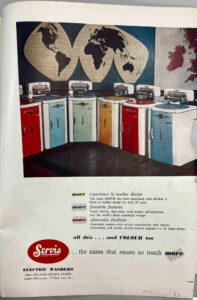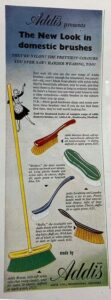Colour and consumer durables in Good Housekeeping magazine
“Color in appliances probably is a thing of mixed emotions to everybody.” Good Housekeeping Institute, 1956
Readers of today’s interior design magazines, viewers of television shows and social media are likely to be familiar with brightly coloured domestic appliances. They appear frequently in idealised home interiors in print and onscreen. Refrigerators come in pastel blues, pinks and greens. Food mixers can be pillar box red or daffodil yellow, and even washing machines display a dash of colour on the handles and buttons.
Today’s consumers may believe that the availability of brightly coloured kitchen appliances is the preserve of the modern kitchen. But everyday items such as cookers and washing machines in vivid hues have been designed and marketed to households longer than we may think.
Good Housekeeping Magazine
Magazines such as Good Housekeeping had an important role in highlighting the visual appeal of household consumer durables, in particular, the kitchen. Founded in America in 1885, the British version of Good Housekeeping was first published in 1922. By the 1950s, it was well embedded in female magazine culture as a lifestyle manual for middle-class women. Advertisements for kitchen appliances ranging from brushes to saucepans available in multiple shades began appearing in British editions of Good Housekeeping magazine from the early 1950s onwards.
Research on women and electrical appliances undertaken in 1951 by an American advertising agency concluded that women desired kitchen goods to harmonise with the rest of their interior decor. Thinking of a washing machine or a saucepan as if it were a fashion accessory, they believed, would help the housewife express her creativity and individuality. Embedding the idea of colour and pleasure relating to housework would ensure favourable associations with kitchen labour.
Colour as a selling point
Studying issues of Good Housekeeping held by MoDA from 1954 onwards it is apparent that ‘colour’ in the home was an increasingly fashionable design trend that the magazine’s home interior editors were relaying to their readers. Rather than colour appearing only in furnishing textiles and home ceramics, colour was used on multiple items in the home. From kitchen units to bathroom suites to cookers; this home interiors trend was increasingly adopted by manufacturers and applied to a slew of domestic goods.

Good Housekeeping, May 1957 Advertisement for Servis washing machines
Good Housekeeping, an influential and widely-read women’s magazine, was quick to foresee these trends coming in from America. This took the form of advertisements and editorials that featured advice on how to make all areas of the home more colourful. Manufacturers of kitchen appliances such as washing machines placed advertisements in the magazine’s home decor pages.
An example from a May 1957 issue depicts a row of ‘Servis’ washing machines ‘colour-styled to match your kitchen’. These models were free-standing and because they were designed as a top-opener, they would not have been boxed into a unit. Therefore, the colour of the front and lid of the machine – available in red, pale blue, green and yellow – was integral to ensuring it looked stylish and appealing from all angles.
It was still relatively unusual for households in the mid-1950s to own a washing machine. They were high-cost items although hire purchase options were available to buyers. (This point was frequently highlighted in the advertisements’ body text).
“Colour makes housework more pleasurable”
 However, even if the cost of a washing machine meant it was beyond the reach of most 1950s households, colour in the kitchen was available in other ways. Brooms and brushes from British manufacturer Addis were a more affordable option
However, even if the cost of a washing machine meant it was beyond the reach of most 1950s households, colour in the kitchen was available in other ways. Brooms and brushes from British manufacturer Addis were a more affordable option
In keeping with the idea that colour in the kitchen made housework more pleasurable, the Addis ‘girl’ had her choice of red, green, blue or yellow, brushes with a wipe-clean wooden handle and colourful polypropylene head. ‘Housework’s so much easier with Addis!”. It was economical too coming in at under 10 shillings for each item.
Colour made its way to cookware including glass pots and pans for use on cookers powered by gas, electricity and solid fuel. For solid fuel users, brightly coloured kitchen hods – containers used to carry coal from the cellar to the kitchen or living room – were designed for the ‘hearth-proud housewife’ to add enjoyment to the unglamorous task of lighting the fire.
Alice comments: “looking at the Good Housekeeping magazines in MoDA’s collections was really helpful for my research. My main focus is the Kenwood Chef, but this process made me consider the ways in which manufacturers used colour to sell a range of other consumer goods.”